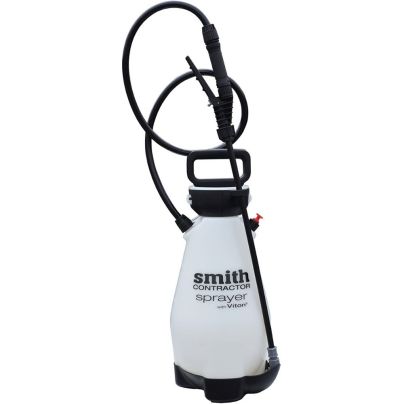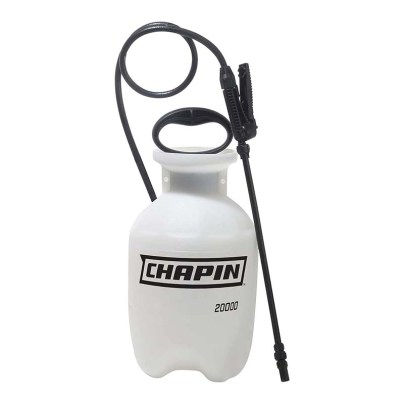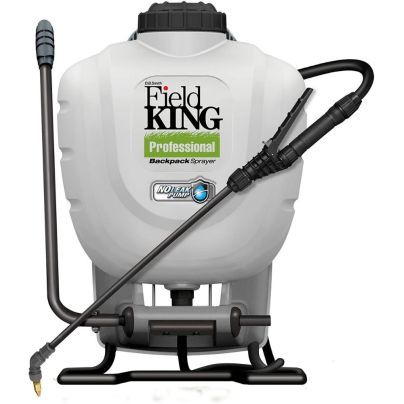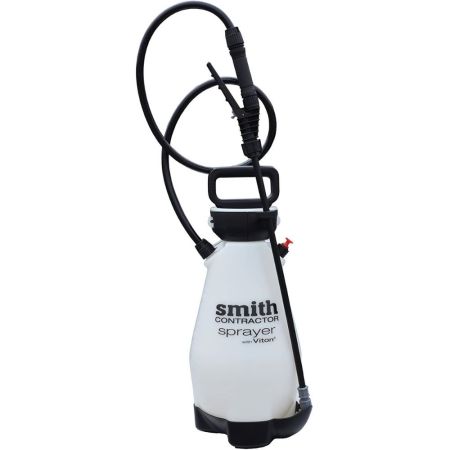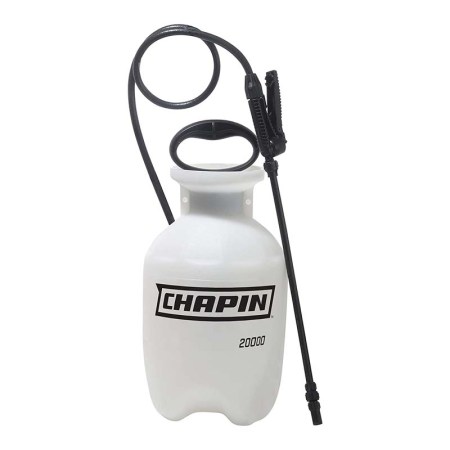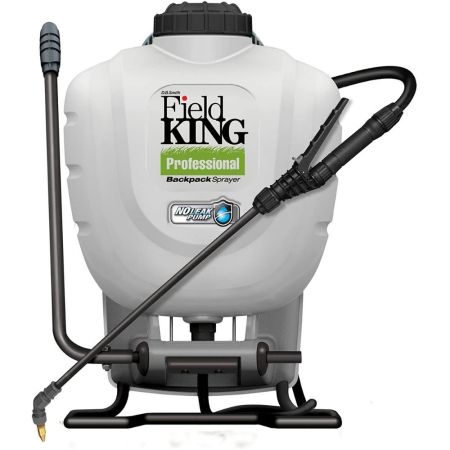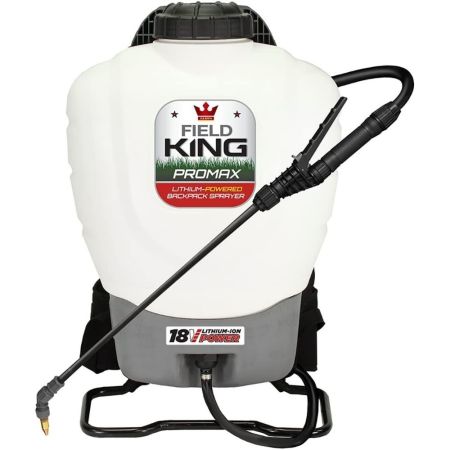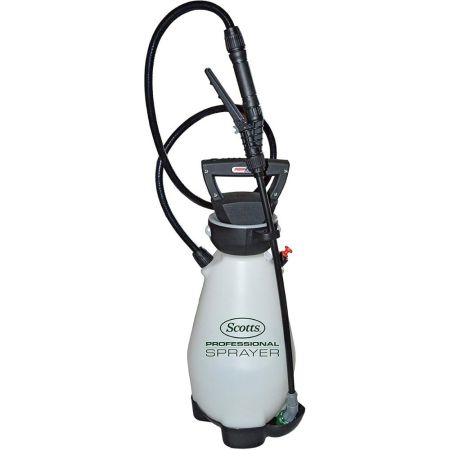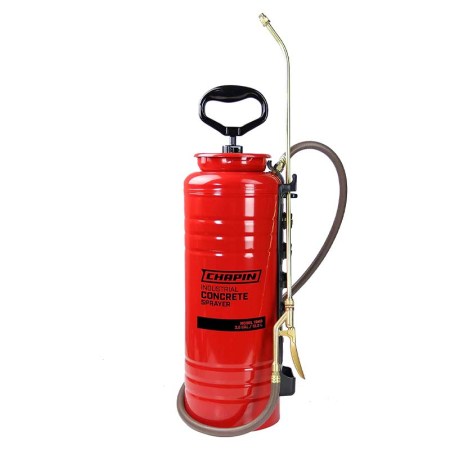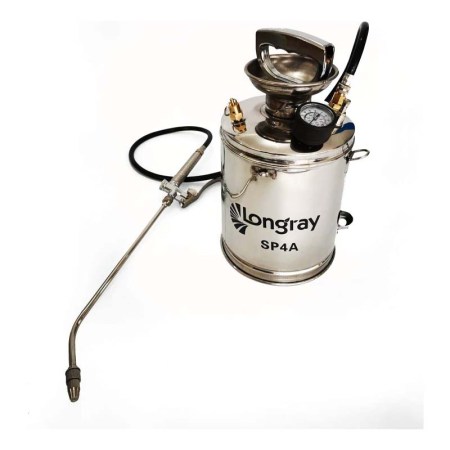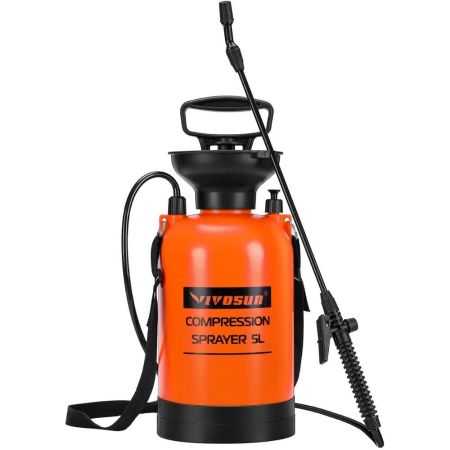We may earn revenue from the products available on this page and participate in affiliate programs. Learn More ›
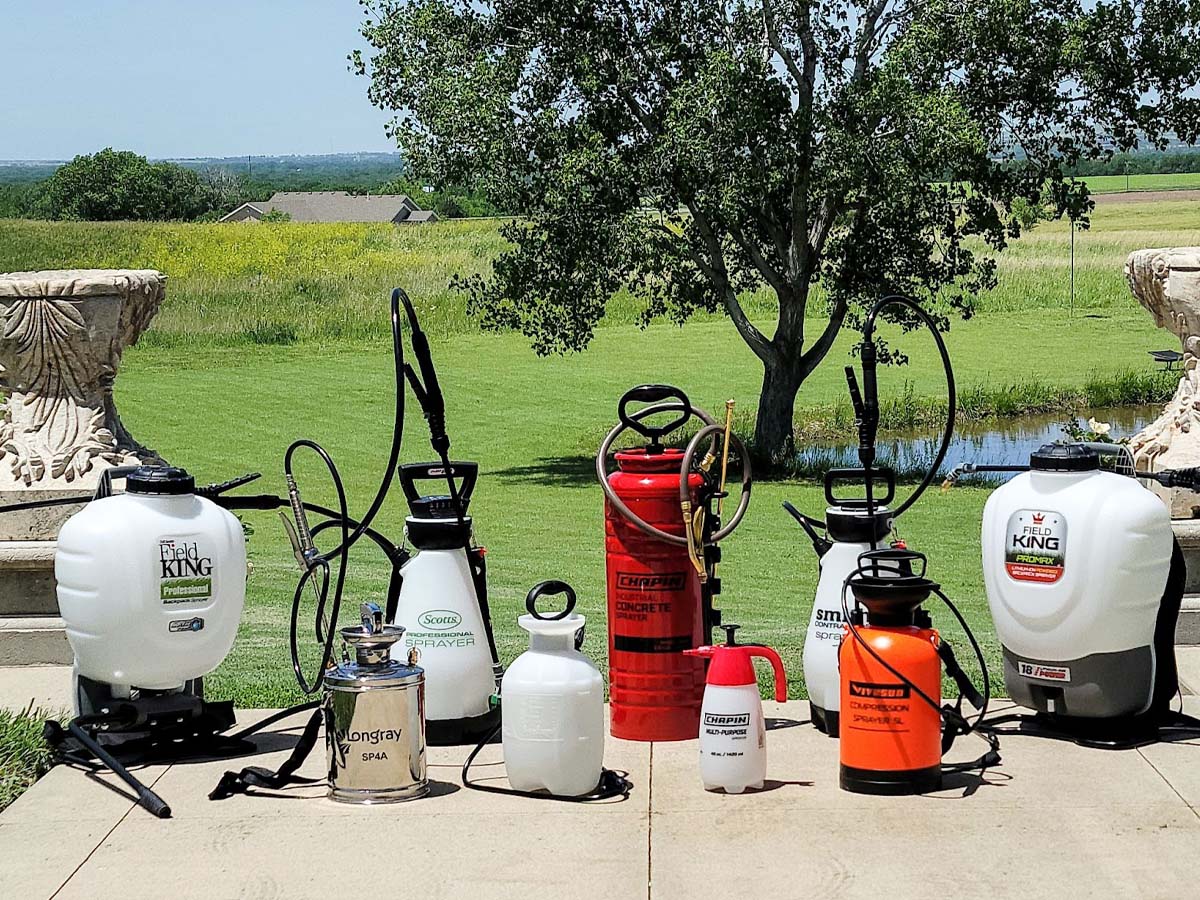
Whether killing off weeds, fertilizing a garden, or keeping pests at bay, pump sprayers are an effective and affordable way to distribute fertilizers, pesticides, and herbicides. However, with so many shapes, sizes, and brands of sprayers to choose from, it can be a challenge to determine which one is appropriate for a particular yard and garden.
That’s why we decided to test the top pump sprayers on the market. We wanted to cut through the hype and find out which sprayers were made from quality materials and would withstand repeated use. We wanted to know which models resisted clogging and which ones came with dependable pump compression. Spoiler alert: Not all the sprayers we tested met our high standards. You can read about any that failed under “Also Tested” below.
Ahead, learn what to look for when shopping for a pump sprayer for your garden or project, and find out how the following sprayers earned a spot on this lineup of the best pump sprayers.
- BEST OVERALL: Smith 2-Gallon Contractor Sprayer
- BEST BANG FOR THE BUCK: Chapin 20000 1-Gallon Lawn and Garden Sprayer
- BEST BACKPACK: D.B. Smith Field King Backpack Sprayer
- BEST BATT.-POWER BACKPACK: Field King Battery-Powered Sprayer
- BEST BATT.-POWER HANDHELD: Scotts Professional Battery-Powered Sprayer
- BEST FOR CONCRETE: Chapin 1949 Industrial Concrete Tank Sprayer
- BEST STAINLESS PICK: Longray SP4A Stainless Steel Hand-Pump Sprayer
- ALSO CONSIDER: Vivosun 1.35-Gallon Pump Pressure Sprayer
ALSO TESTED: Chapin 1002 48-Oz Multi-Purpose Sprayer
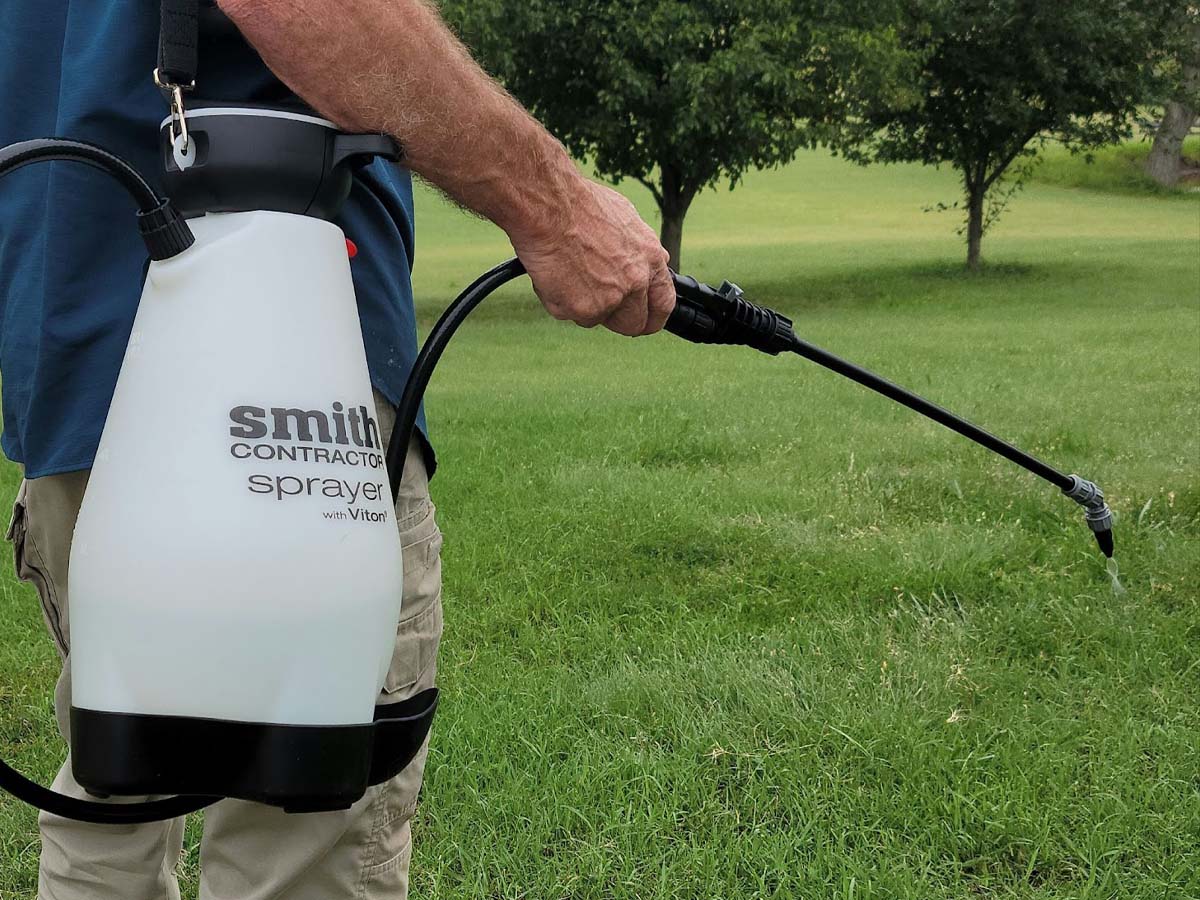
How We Tested the Best Pump Sprayers
To begin with, we selected the top-rated pump sprayers in various categories, including compact models, large manual-pump models, battery-operated sprayers, and even a couple of specialty steel-body sprayers to cover all the bases.
Testing the sprayers was simple and straightforward—we assembled the sprayers (if necessary), examined their construction, and then filled them with water. We pressurized the sprayers, either by hand pumping or via battery-powered pumps. We even pressured one model using an air compressor and a tire valve.
Once filled and pressurized, we checked each of the sprayers for both water and air leaks, and then we tested their spray abilities. Throughout the testing process, we continued to check for any leaking, and we tried every nozzle that came with the sprayers.
We awarded points based on a rubric for quality, durability, versatility, functionality, comfort, and ease of use. At the end of the testing, we added the points and used them to determine the best categories for each sprayer.
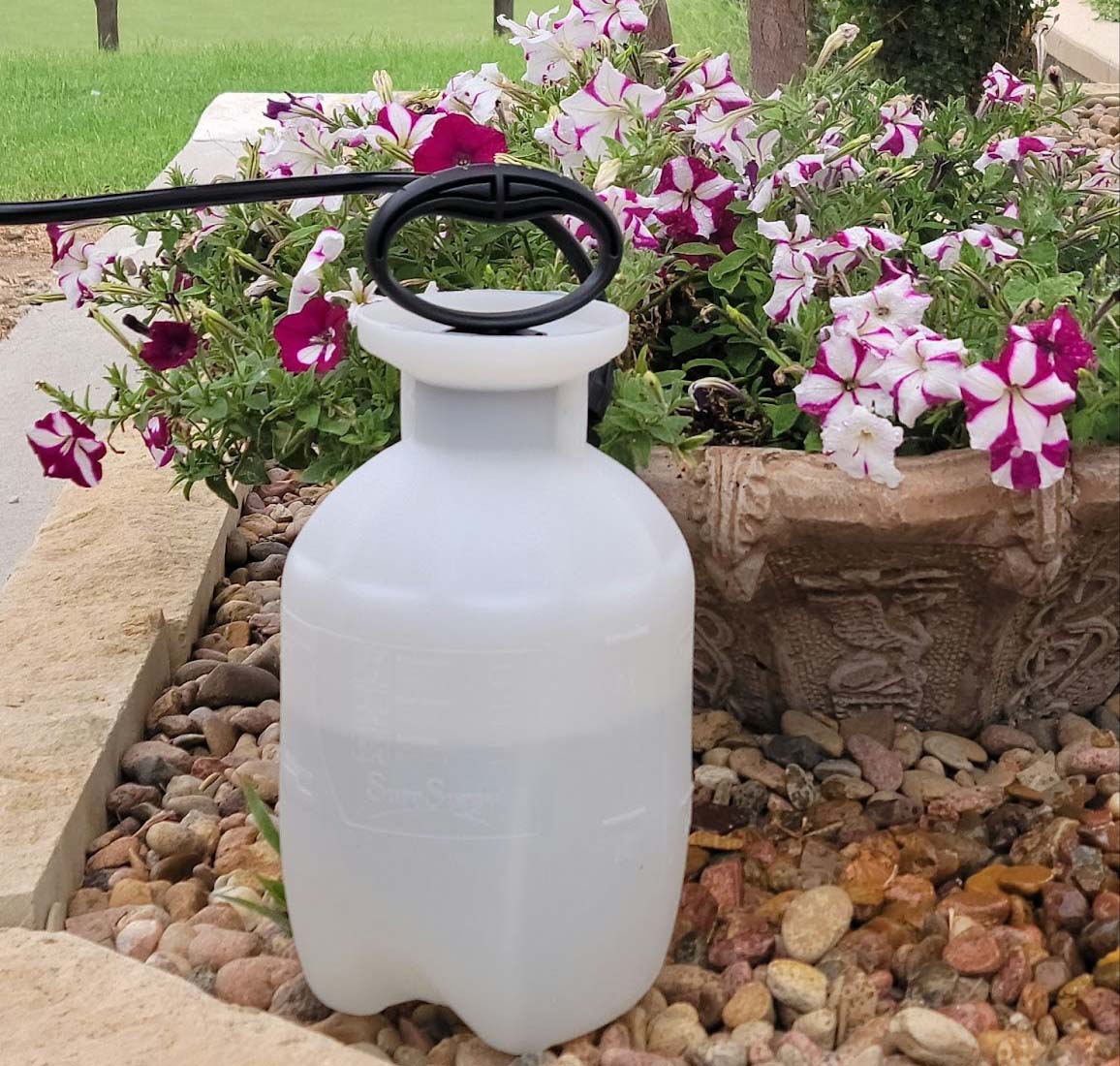
Our Top Picks
The list below features the pump sprayers that excelled in our hands-on tests and earned a spot on this lineup. In order to make the cut, each of the following sprayers had to be simple to use, retain tank pressure without leaking, and come with a nozzle that efficiently distributed the spray stream. Keep reading to discover the pros and cons of each model and discover which pump sprayer is best suited to your needs.
Best Overall
Smith 2-Gallon Contractor Sprayer
See ItThis pump sprayer from D.B. Smith boasts high-quality construction, multiple nozzles that add versatility, and a large capacity while still being affordable, making it among the best options for home use. Its 2-gallon capacity is enough to handle larger jobs around the yard, including treating a lawn, larger flower beds, shrubs, and even small trees.
We filled the D.B. Smith sprayer tank with water and manually pumped it to increase pressure in the tank. The pump handle is large and smooth, and it took about 25 pumps to reach the pressure level where it became difficult to pump anymore. This sizable sprayer is relatively heavy when full, so we appreciated the adjustable canvas shoulder strap for carrying.
We sprayed various surfaces, including grass, flowers, and concrete, testing each of the included nozzles. We could twist the two adjustable nozzles to emit streams or wide cones of spray. The two fan nozzles delivered flat spray patterns well suited to rinsing off a car or bicycle. To test the foaming nozzle, we added a bit of liquid dish detergent to the tank, and the nozzle emitted bubbly foam that was perfect for soaping down the car.
We experienced no liquid or air leaks during use, and we thought the 21-inch spray wand was a good length for most spraying tasks. Plus, it came with a lockable trigger that allowed us to deliver the spray stream without needing to squeeze the trigger constantly.
We found the D.B. Smith pump sprayer to be an excellent all-around sprayer. Its capacity was large enough that we didn’t have to keep refilling, yet it wasn’t too large to carry.
Product Specs
- Capacity: 2 gallons
- Manual or battery-powered: Manual
- Nozzles: 5 (1 poly, 1 brass, 2 flat fans, 1 foaming)
Pros
- Pressure-release valve (for bleeding-off tank)
- Quality construction (no leaking gaskets)
- Comes with a large pump handle and canvas carry strap
Cons
- Wand holder didn’t grip the wand securely
Get the Smith Contractor pump sprayer at Amazon, The Home Depot, or Big Frog Supply.
Best Bang for the Buck
Chapin 20000 1-Gallon Lawn and Garden Sprayer
See ItFertilizing smaller gardens and flower beds doesn’t require an expensive pump sprayer. This affordable model from Chapin International is an excellent option for those needing a sprayer for occasional use.
With a 1-gallon capacity and 12-inch spray wand, we found the Chapin International 20000 sprayer compact, lightweight, and ready for small gardening tasks. We filled it with water and pumped the tank about 20 times before it reached maximum pressure, and then we couldn’t pump it anymore. The pump handle locked into place and also served as a carrying handle, which was quite convenient.
The Chapin sprayer comes with just one nozzle, but it’s adjustable, and with a twist we were able to regulate the stream—from a jet to a wide circle of spray. The Chapin 20000 didn’t leak air or water. We went through the water in the tank pretty quickly—about 15 minutes—but this is a light-duty sprayer. It offers durable construction, an ergonomic pump handle, and efficient spraying at a very attractive price point.
Product Specs
- Capacity: 1 gallon
- Manual or battery-powered: Manual
- Nozzles: 1 (adjustable)
Pros
- Affordable compared to similar options on the market
- No-leak gaskets keep a tight pressurized interior
- Ergonomic handle feels comfortable to hold for long periods
- Perfect small-duty sprayer for light jobs
Cons
- May need to refill often if used for larger areas
Get the Chapin 20000 pump sprayer at Amazon or The Home Depot.
Best Backpack
D.B. Smith Field King Backpack Sprayer
See ItThis pro-level Field King backpack sprayer from D.B. Smith boasts a sturdy build and efficient design. With its large 4-gallon capacity, we would have struggled to carry this sprayer around, so we were relieved that it came with a backpack harness.
We set the Field King on the tailgate of a pickup truck before filling it with water. When full, the Field King was quite heavy—about 45 pounds—and we didn’t want to try picking it up and putting it on our backs. By setting it on the tailgate, we could slip our arms into the harness easily. The harness comes with padded chest straps and a padded back strap, but we would have liked slightly more padding on the back strap, as the bottom of the tank still pressed uncomfortably against our lower backs.
The big difference with this manual pump sprayer is that we didn’t need to pull and push a handle up and down—the pumping is accomplished via a bar that sits horizontally at waist level. By grabbing the end of the bar and moving it up and down, we were able to pressurize the tank quickly.
The D.B. Field King comes with a 21-inch poly wand and four nozzles—two flat fans, an adjustable brass nozzle, and a foaming nozzle. The flat and adjustable nozzles worked well. We added a bit of liquid dish soap to test the foaming nozzle—it worked adequately, but the foam wasn’t as fine and uniform as some of the other foaming nozzles we tested.
The pump sprayer uses an internal piston pump that keeps it at a constant 25 pounds per square inch (psi) but can be adjusted to deliver up to 150 psi to reach longer distances. High-end seals prevent leaks in the connections to the tube and the 21-inch poly wand. An ergonomic grip makes the wand comfortable to use, while the lockable trigger prevents accidental spills.
This is a formidable pump sprayer, but it isn’t for everyone. It requires a user with a strong back to carry its filled weight. It’s well suited for large spraying projects, such as fertilizing a sizable lawn without needing to refill a spray tank frequently.
Product Specs
- Capacity: 4 gallons
- Manual or battery-powered: Manual
- Nozzles: 4 (2 flat fans, 1 brass adjustable, 1 foaming)
Pros
- Large tank capacity suitable for extended use
- Handy pump arm makes it easier to pump
- Padded harness straps more comfortable for long uses
- Can regulate spray pressure to different tasks
Cons
- Heavy when full; may be a strain on some users
- Some assembly required
Get the D.B. Smith Field King pump sprayer at Amazon or The Home Depot.
Best Batt.-Power Backpack
Field King Battery Powered Sprayer
See ItThe second backpack sprayer we tested, this Field King sprayer, was simpler to operate thanks to its battery-powered pump.
Like many backpack sprayers, it holds 4 gallons, so we once again used a pickup tailgate when filling it so we could slip right into the harness rather than picking it up and putting it on. The harness on this sprayer was very well designed and comfortable—no parts of the sprayer pressed against our backs.
Some initial assembly is required, and the 18-volt lithium-ion battery must be charged before using the sprayer. A slight downside is the need to remove the battery from the back of the sprayer each time it needs a charge—we would have preferred a built-in battery and a cord that plugged right into the unit. Still, having battery power is a big plus.
On a full charge, we could continuously use the sprayer for nearly 2 hours before it started losing its charge. The manufacturer claims the battery charge lasts about 3.5 hours, which might be accurate in a typical spraying situation where the user isn’t spraying constantly.
We tested the four nozzles that came with the sprayer—low-volume and high-volume flat fans, a foaming nozzle, and a brass adjustable nozzle. All four performed exceptionally well. The high-volume flat fan sprayed a distance of almost 10 feet, making it well suited for reaching distances such as upper fruit-tree branches.
Product Specs
- Capacity: 4 gallons
- Manual or battery-powered: Battery (18 volts)
- Nozzles: 4 (low-volume fan, high-volume fan, adjustable brass, foaming)
Pros
- Comfortable padded harness
- No pumping necessary
- Maintains consistent spray pressure
Cons
- Pricey
Get the Field King battery-powered pump sprayer at Amazon or Green Thumb Mowers.
Best Batt.-Power Handheld
Scotts Professional Battery-Powered Sprayer
See ItThis battery-powered pump sprayer from Scotts eliminates the periodic pumping that manual sprayers require, making it an ideal option for bigger jobs. It comes with a built-in battery located in the base of the handle, and all we had to do was unscrew the handle and plug the included charger into the side of the base.
After completely charging the battery, indicated by a green light, we filled the Scotts sprayer and started testing. The on-off button is located on the very top of the handle, and we found it convenient to press whenever we wanted to start or stop the battery pump. The pump is relatively loud—don’t expect to sneak around while spraying—but it does the job well.
We were able to spray 13 full tanks of water before needing to recharge. This was slightly better than the manufacturer’s claims of 12 tanks on a single charge. Only one nozzle comes with the Scotts’ sprayer, but it’s versatile. It adjusts from a fan to a stream to a cone, so it covers most spray pattern bases without the need to swap out nozzles.
While we had to stop to refill the tank, it was nice not to have to pump up the pressure manually each time. We would have liked a carrying strap, however. When full, the tank weighs around 18 pounds, and a shoulder strap would go a long way toward making it more convenient to carry.
We liked the pressure-release valve located near the handle. For those spraying chemicals, this valve allows them to release pressure in the tank without accidentally getting some of the spray on them, which is a recurring problem with sprayers that depend on loosening the handle to release pressure.
Product Specs
- Capacity: 2 gallons
- Manual or battery-powered: Battery (built-in handle base)
- Nozzles: 1 (adjusts to fan, cone, or stream)
Pros
- No pumping necessary; all done with the battery
- Easy-to-access on-off button
- Convenient charging in handle base
Cons
- No carry strap, can be tiring to use for long periods
Get the Scotts pump sprayer at Amazon or The Home Depot.
Best for Concrete
Chapin 1949 Industrial Concrete Tank Sprayer
See ItThe Chapin International 1949 Open Head Sprayer draws the eye with its fire-engine red exterior, but its benefits are more than just aesthetic. Many DIYers who pour their own concrete sidewalks and patios need to keep them misted with water or treated with a concrete sealer, and that’s where the 1949 shines.
The steel tank holds 3.5 gallons and comes with a lined interior that’s designed to resist corrosion or rusting. After admiring the high quality of the sprayer, we filled it up and immediately ran into a problem with the top not sealing. Despite our attempts to get it to seal, it wouldn’t. The tank didn’t have any instructions addressing this issue, but we found a YouTube video that showed us how to loosen a steel nut at the top, which allowed the top to fit into the grooves on the tank and seal tightly.
It took about 25 pumps to reach compression in the spray tank, and we started spraying. The 1949 sprayer has just one nozzle, but that’s all it needs—it’s a wide-fan nozzle that’s just right for applying a uniform application of water or sealant. The pump handle does double duty as a carrying handle, but we would have also appreciated a shoulder strap.
The 1949 is a bit heavy and bulky for a traditional garden sprayer, but it’s an excellent choice for a concrete sprayer or for spraying chemicals or cleaners on siding or decking.
Product Specs
- Capacity: 3.5 gallons
- Manual or battery-powered: Manual
- Nozzles: 1 (brass wide-fan nozzle)
Pros
- Heavy-duty steel body is durable and long-lasting compared to plastic
- Lined interior helps resist corrosion and rusting
- Wide-fan nozzle for uniform application
Cons
- No carry strap; can be cumbersome to move around
- Top won’t seal if steel nut is too tight
Get the Chapin 1949 pump sprayer at Amazon, The Home Depot, or CleanItSupply.com.
Best Stainless Pick
Longray SP4A Stainless Steel Hand-Pump Sprayer
See ItRight out of the box, the Longray Stainless Steel Sprayer dazzled us with its high sheen and quality design. While it only holds 1 gallon, it’s very well made. The tank, pump handle, and even the wand and nozzle are all made from stainless steel to resist rusting and corrosion. This tank could last its user a lifetime if certain chemicals are not used, including bleach and some types of pesticides that are not compatible with steel (check product label).
We filled the Longray sprayer with water, and it took about 20 pumps until we felt it was pressurized. We checked the gauge, and it told us the pressure in the tank was 85 psi. The gauge went up to 100 psi, but we didn’t want to push it. It comes with only one nozzle, which is adjustable from a fine mist to a strong cone spray. The wand is 20 inches long, slightly on the short side if users want to reach distances longer than a few feet.
This is a very well-built little sprayer, and it comes with another interesting feature we didn’t find on any of the other sprayers we tested: a tire valve. This stainless steel valve allowed us to attach a compressor hose with a tire-pump nozzle. It was quick and painless to pump up the Longray sprayer, so users with air compressors have an added option for pressuring this tank.
Product Specs
- Capacity: 1 gallon
- Manual or battery-powered: Manual, but can be attached to an air compressor
- Nozzles: 1 (adjusts from fine mist to cone)
Pros
- Durable, stainless steel construction with no-leak seals
- Stainless steel wand more durable than plastic options
- Pressure gauge and tire valve allows for more accuracy
Cons
- Pricey compared to simpler options
- Can’t be used with chemicals that corrode steel
Get the Longray pump sprayer at Amazon or The Home Depot.
Also Consider
Vivosun 1.35-Gallon Pump Pressure Sprayer
See ItWith a 1.35-gallon tank, this Vivosun sprayer has enough capacity for many garden applications, such as treating yards, large flower beds, and shrubs while still being small enough to maneuver easily. We agreed that the sprayer’s bright orange color would keep it from getting lost in the back of a crowded garage or storage shed.
We liked the inclusion of a convenient shoulder strap that made it simple to carry the sprayer. Unlike some other plastic tank sprayers, the Vivosun features a slightly weighted base that keeps it from tipping over when set on the ground. It comes with a 22-inch wand that’s well suited to many garden and around-the-house spraying tasks.
After filling the tank with water, it took about 20 pumps to reach maximum compression, where it became hard to pump any longer. It comes with just one nozzle, but it’s adjustable, and we were able to switch between a fine mist that would be perfect for spraying some types of foliage, such as ferns, and a strong stream powerful enough to rinse dirt off the car’s tires. But, those were the only two spray variations.
Another feature we appreciated that other plastic sprayers don’t always have was a wide, bowl-type funnel at the top that helped us fill the tank without spilling water on the ground. This would be especially helpful when spraying chemicals. The Vivosun also includes a release valve that works well to let the pressure out of the tank safely.
Product Specs
- Capacity: 1.35 gallons
- Manual or battery-powered: Manual
- Nozzles: 1 (adjustable)
Pros
- Compact size makes this ideal for small jobs
- Shoulder carry-strap more convenient for carrying around
- Features a release valve and non-tip base
Cons
- Only 1 nozzle included; limited spray pattern options
Get the Vivosun pump sprayer at Amazon.
ALSO TESTED
Chapin 1002 48-Oz Multi-Purpose Sprayer
We really wanted to like the Chapin International 1002 pump sprayer. Unfortunately, it failed early in our hands-on tests. We filled the little sprayer with water and pumped it to increase the pressure in the tank.
When we depressed the thumb trigger, water sprayed out of the spot where the nozzle connected to the stem. At first, we thought we hadn’t connected the nozzle well enough, but the water continued spraying out the sides even after tightening it. We removed the nozzle and discovered the stem itself was cracked. No matter how we adjusted the nozzle tip, the water would spray in all directions.
Something obviously happened to damage the stem. We had to eliminate the sprayer at that point from our testing but, based on our research, we feel as though the cracked stem was likely a fluke. Chapin International is a reputable manufacturer, and we would not hesitate to try testing this model again in the future.
Jump to Our Top Picks
What to Consider When Choosing a Pump Sprayer
Pump sprayers consist of a 1- to 6-gallon plastic or steel tank, a manual or mechanical pump, and a long wand. They have adjustable or interchangeable nozzles that allow the user to distribute the spray in patterns ranging from a narrow stream to a broad fan. These handy gardening and DIY tools are available in one-handed and two-handed models, backpack options, and large but portable wheeled sprayers.
Sprayer Types
- Backpack sprayer: A backpack sprayer has a tank with straps that allow the user to carry the sprayer on their back. This type of sprayer has a greater volume than a handheld sprayer, and the design makes it easier to carry.
- Hose-end sprayer: A hose-end sprayer attaches to the end of a hose and mixes the water and the chemicals as the water passes through the nozzle. Since the chemicals are concentrated and the hose supplies a limitless amount of water, this type of sprayer is ideal for covering large areas.
- Handheld sprayer: A handheld sprayer consists of a plastic or metal basin with a pump that doubles as a handle and a wandlike applicator. This type of sprayer is ideal for smaller applications, such as fertilizing a flower garden or treating weeds growing through a walk.
- Wheeled sprayer: A wheeled sprayer features a tank atop a wheeled frame that allows the user to wheel the sprayer around the yard. This type of sprayer holds more liquid than a handheld or a backpack sprayer, making it ideal for larger applications, such as treating an entire yard.
- Battery-powered sprayer: A battery-powered sprayer replaces the manual pumping action required for a traditional pump sprayer with batteries. The battery powers a small pump that maintains the required pressure in the tank to push the liquid through the sprayer nozzle. Battery-powered sprayers are similar to paint sprayers but have less power. This type of sprayer offers convenience as it eliminates the need to pump the sprayer periodically to create pressure in the tank.
Pump Style
Pump sprayers work either with a manual piston system or a battery-powered pump. A sprayer with a piston system has a large handle that the user pumps manually to pressurize the tank. This pressure forces the liquid out of the nozzle when the user pulls the trigger. The pressure decreases as the pump operates, forcing the user to increase the pressure in the tank periodically by pumping the piston. Battery-powered sprayers have a small electric motor that creates pressure in the tank, eliminating the need for the user to pump the sprayer by hand.
Size and Tank Capacity
Pump sprayers vary in wand length and tank size. Wand length determines the distance between the user and the nozzle, which is important when applying pesticides, fertilizers, and other chemicals that can be harmful if they come into contact with eyes or skin. Most pump sprayers have wands that range in length from 18 to 22 inches.
Tank capacity determines how long the pump sprayer can operate before requiring a refill. Capacity ranges from ¾ gallon for smaller one-hand sprayers and up to 2 gallons for handheld sprayers. Backpack and wheeled sprayers have tank sizes that range from 3 to 6 gallons.
Material
Pump-sprayer materials need to be strong enough to endure the fertilizers and chemicals they hold while still being lightweight enough to carry, roll, or wear on one’s back. As such, many pump sprayer basins consist of heavy-duty plastic with wands that have brass, aluminum, or stainless steel nozzles. A few models feature stainless steel tanks for increased durability.
While pump sprayers with plastic nozzles may be less expensive, brass and stainless steel are more durable and much less likely to crack. These metals also won’t rust or corrode, which makes them ideal for pump sprayers.
Weight
Since the user needs to maneuver a pump sprayer around the yard, weight is a key factor. The liquid fertilizers or chemicals that fill the basin make up the majority of the pump sprayer’s total weight, so take that into consideration. A quart of liquid weighs just over 2 pounds, while a gallon weighs a little more than 8 pounds. Add the empty weight of the sprayer to the weight of its max capacity to determine the overall weight of the pump sprayer.
Handheld sprayers are the lightest, with an empty weight of about 5 pounds. Backpack sprayers are heavier at around 12 pounds, while wheeled sprayers are the heaviest at around 15 pounds.
Nozzle
The nozzle determines the spray pattern and output volume of the pump sprayer. Most sprayers have adjustable nozzles that change the shape of the spray pattern from a broad fan to a narrow stream by turning it clockwise or counterclockwise. Many sprayers also include multiple nozzles that the user can switch out to suit different types of applications. These interchangeable nozzles typically include a foaming nozzle, an adjustable nozzle, and fan nozzles of varying widths.
Maintenance
Most pump sprayers are built to handle a variety of needs, ranging from weed control to lawn fertilization to pest control, and must be periodically refilled. Some sprayers include a manual or automatic pressure regulator that prevents the tank from over-pressurizing, which can put too much pressure on the seals and create leaks or cause the tank to spray chemicals from the opening when the user opens the lid. Users should also clean the spray assembly from time to time, as it can get clogged.
Tips for Buying and Using Pump Sprayers
It’s important to follow a few tips and guidelines to maximize the use of a pump sprayer and ensure a long life.
- Spray downwind. Pump sprayers have long wands for a reason. The fertilizers, pesticides, and weed-control ingredients present in the chemicals these sprayers distribute are toxic. A 20-inch wand allows the user to operate the sprayer without splashing chemicals on their skin or in their eyes. With that in mind, users should spray with the wind at their backs.
- Choose the right nozzle. Pump sprayers also include different-size nozzles for a reason. Select a wide fan to treat beds and lawns and provide the most coverage while not oversaturating one specific area. Use a stream to target weeds growing through a walkway to avoid wasteful overspray. For applying pesticides to shrubs and bushes, use a foaming nozzle.
- Don’t over-pressurize the tank. One common mistake with manual piston-pump sprayers is that users over-pressurize them to increase the output. If the sprayer doesn’t have an automatic pressure-relief valve, this can put more strain on the tank and the seal in the nozzle, damaging the seal and leading to leaks.
- Depressurize when finished. Many people use a pump sprayer to treat weeds or fertilize plants then put it away still loaded with pressure. This pressure creates a constant force on the seals that can cause leaks. Use a pressure-relief valve or unscrew the lid slightly to allow the pressure to release before storing the sprayer.
FAQs
If you’re wondering about the range of your new pump sprayer, the applications for which you can use it, or how to maintain it, then read on for answers to some of the most frequently asked questions about these handy gardening tools.
Q. How far will a pump sprayer spray?
The range of a pump sprayer depends on the spray pattern. It will spray the farthest when set to a narrow stream. Most pump sprayers can spray up to 20 feet, and some more powerful sprayers are capable of reaching 30 feet.
Q. What do I do if my pump sprayer gets clogged?
If your pump sprayer gets clogged, it’s likely because sediment or dirt has become lodged in the sprayer’s nozzle. Remove the nozzle and clean it with water using a hose. Then, replace the nozzle.
Q. Are pump sprayers safe to use for painting?
It’s not suggested. The types of sprayers used to paint cabinets, trim, and other surfaces are usually pressurized by air compressors that maintain a steady paint pressure. An airless sprayer is better suited for painting. Rather than attempting to spray-paint with a pump sprayer, consider rolling on the paint.
Q. How do I clean my pump sprayer?
To clean your pump sprayer, begin by rinsing out the tank with fresh water. Once clean, fill the tank with fresh water and then assemble the sprayer. Spray fresh water through the tube and nozzle to clean any chemicals out of it. Remove the nozzle and rinse it using a hose.
Q. Are pump sprayers effective for spraying pests?
Yes. Pump sprayers are a good option for applying pest control. However, they tend to distribute liquids at a high volume, so they may be unsuitable for indoor use.
Q. Are pump sprayers safe around my pets and children?
Pump sprayers themselves do not produce enough force—significantly less than a garden hose—to pose a threat to pets and children. That said, most of the time, these sprayers are spraying toxic chemicals, so keep children and pets away when using them.
Q. What precautions should I take when using a pump sprayer?
Wear gloves and goggles to protect the skin and eyes from the dangerous chemicals the pump sprayer distributes. Use the wand’s length to help you maintain a safe distance from the nozzle, and spray downwind to prevent the chemicals from being blown back at you.
